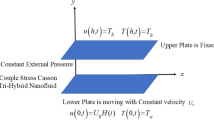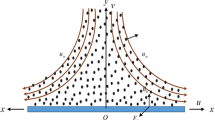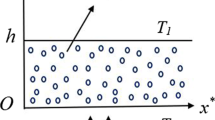Abstract
The blood flow with heat transportation has prominent clinical importance during the levels where the blood flow needs to be checked (surgery) and the heat transportation rate must be controlled (therapy). This work presents an analysis of the melting heat transport of blood, which consists of iron nanoparticles along free convection with cross-model and solution of the partial differential equation (PDEs) are emerged by the mathematical model. Being the importance of iron oxide nanoparticles in applications of the biomedical field due to their intrinsic properties such as colloidal stability, surface engineering capability and low toxicity, this study has been launched. Furthermore, PDEs of the problem are converted into a set of nonlinear ordinary differential equations (ODEs) by proper transformations. The solution of this system of ODEs is calculated through RK 4 method and Keller–Box scheme. Some leading points and numerical results of this study of both types of presence and absence of meting effects are tabulated.

















Similar content being viewed by others
Data availability statement
No data are used to support this study.
Abbreviations
- \(V,\tau\) :
-
Velocity, Cauchy tensor
- \(p,I,A_{1}\) :
-
Pressure, identity tensor, Rivilin tensor
- \(\mu_{\infty } ,\mu_{0}\) :
-
Lower shear rate and higher shear rate viscosity,
- \(A = \frac{a}{c}\) :
-
Unsteady parameter
- \(\lambda = \frac{{g\beta_{{\text{f}}} \left( {T_{2} - T_{{\text{m}}} } \right)}}{{u_{{\text{w}}}^{2} }}\) :
-
Convection parameter
- \(M = \frac{{\left( {C_{{\text{p}}} } \right)_{{\text{f}}} \left( {T_{2} - T_{{\text{m}}} } \right)x}}{{\lambda^{*} + c_{{\text{s}}} \left( {T_{{\text{m}}} - T_{0} } \right)}}\) :
-
Melting parameter
- \(\Pr = \frac{{\left( {\rho C_{{\text{p}}} } \right)_{{\text{f}}} }}{{\mu_{{{\text{nf}}}} }}\) :
-
Prandtl number
- \({\text{Re}}_{x} = \tfrac{{\left( {u_{{\text{w}}} } \right)}}{{\upsilon_{{\text{f}}} }}\) :
-
Reynold number
- \(\beta_{{{\text{nf}}}} \left( {\frac{1}{{\text{K}}}} \right)\) :
-
Coefficient of thermal expansion
- \(k_{{{\text{nf}}}} \left( {\frac{{\text{W}}}{{{\text{Km}}}}} \right)\) :
-
Effective thermal conductivity
- \(\rho_{{\text{f}}} \left( {\frac{{{\text{kg}}}}{{{\text{m}}^{3} }}} \right)\) :
-
Reference density of fluid
- \(\rho_{{\text{s}}} \left( {\frac{{{\text{kg}}}}{{{\text{m}}^{3} }}} \right)\) :
-
Reference density of solid
- \(\mu_{{\text{f}}} \left( {\frac{{{\text{Ns}}}}{{{\text{m}}^{2} }}} \right)\) :
-
Viscosity of fluid
- \(\lambda^{*} \left( {\frac{{\text{J}}}{{{\text{kg}}}}} \right)\) :
-
Latent heat transfer of fluid
- \(c_{{\text{s}}} \left( {\frac{{\text{J}}}{{\text{K}}}} \right)\) :
-
Heat capacity of solid surface
- \({\text{We}}\) :
-
Weissenberg number
- \(u\left( {\text{m/s}} \right)\) :
-
Velocity along x-axis
- \(v\left( {\text{m/s}} \right)\) :
-
Velocity along y-axis
- \(T_{1} \left( {\text{K}} \right)\) :
-
Temperature of nanofluid
- \(T_{2} \left( {\text{K}} \right)\) :
-
Temperature of ambient fluid
- \(\rho_{{{\text{nf}}}} \left( {\frac{{{\text{kg}}}}{{{\text{m}}^{3} }}} \right)\) :
-
Density of nanofluid
- \(\mu_{{{\text{nf}}}} \left( {\frac{{{\text{Ns}}}}{{{\text{m}}^{2} }}} \right)\) :
-
Effective viscosity of nanofluid
- \(g\left( {{\text{m/s}}^{2} } \right)\) :
-
Gravitational acceleration
- \(\phi\) :
-
Visibility of concentration
- \(k_{{\text{f}}} \left( {\text{W/Km}} \right)\) :
-
Thermal conductivity of fluid
- \(k_{{\text{s}}} \left( {\text{W/Km}} \right)\) :
-
Thermal conductivity of solid
- \(a,c\) :
-
Constant
- \(n\) :
-
Cross-fluid index
References
Maxwell JC (1873) A treatise on electricity and magnetism, vol 1. Clarendon Press, Oxford
Jeffrey DJ (1973) Conduction through a random suspension of spheres. Proc R Soc Lond Math Phys Sci 335(1602):355–367
Obrien RW (1979) A method for the calculation of the effective transport properties of suspensions of interacting particles. J Fluid Mech 91(1):17–39
Latos E, Suzuki T (2020) Mass conservative reaction diffusion systems describing cell polarity. arXiv: 2006.12907
Yano T, Nishino K (2020) Numerical study on the effects of convective and radiative heat transfer on thermocapillary convection in a high-Prandtl-number liquid bridge in weightlessness. Adv Sp Res 66:2047
Axmann S, Pokorny M (2019) Steady solutions to a model of compressible chemically reacting fluid with high density. arXiv preprint arXiv: 1912.12543
Egger H, Philippi N (2020) On the transport limit of singularly perturbed convection-diffusion problems on networks. arXiv preprint arXiv: 2004.09490
Wahab A, Hassan A, Qasim MA, Ali HM, Babar H, Sajid MU (2019) Solar energy systems—potential of nanofluids. J Mol Liq 289:111049
Shah TR, Ali HM (2019) Applications of hybrid nanofluids in solar energy, practical limitations and challenges: a critical review. Sol Energy 183:173–203
Michael JJ, Iniyan S (2015) Performance analysis of a copper sheet laminated photovoltaic thermal collector using copper oxide–water nanofluid. Sol Energy 119:439–451
Chen W, Zou C, Li X (2019) Application of large-scale prepared MWCNTs nanofluids in solar energy system as volumetric solar absorber. Sol Energy Mater Sol Cells 200:109931
Yurddaş A (2020) Optimization and thermal performance of evacuated tube solar collector with various nanofluids. Int J Heat Mass Transf 152:119496
Abbas N, Awan MB, Amer M, Ammar SM, Sajjad U, Ali HM et al (2019) Applications of nanofluids in photovoltaic thermal systems: a review of recent advances. Phys A 536:122513
Radwan A, Ahmed M (2018) Thermal management of concentrator photovoltaic systems using microchannel heat sink with nanofluids. Sol Energy 171:229–246
Mercan M, Yurddaş A (2019) Numerical analysis of evacuated tube solar collectors using nanofluids. Sol Energy 191:167–179
Crane LJ (1970) Flow past a stretching plate. Zeitschrift für angewandte Mathematik und Physik ZAMP 21(4):645–647
Mukhopadhyay S (2013) Slip effects on MHD boundary layer flow over an exponentially stretching sheet with suction/blowing and thermal radiation. Ain Shams Eng J 4(3):485–491
Bhattacharyya K, Mukhopadhyay S, Layek GC, Pop I (2012) Effects of thermal radiation on micropolar fluid flow and heat transfer over a porous shrinking sheet. Int J Heat Mass Transf 55(11–12):2945–2952
Turkyilmazoglu M (2014) Exact solutions for two-dimensional laminar flow over a continuously stretching or shrinking sheet in an electrically conducting quiescent couple stress fluid. Int J Heat Mass Transf 72:1–8
Alsaedi A, Awais M, Hayat T (2012) Effects of heat generation/absorption on stagnation point flow of nanofluid over a surface with convective boundary conditions. Commun Nonlinear Sci Numer Simul 17(11):4210–4223
Escudier MP, Gouldson IW, Pereira AS, Pinho FT, Poole RJ (2001) On the reproducibility of the rheology of shear-thinning liquids. J Nonnewton Fluid Mech 97(2–3):99–124
Barnes HA, Hutton JF, Walters K (1989) An introduction to rheology, vol 3. Elsevier, Oxford
Xie J, Jin YC (2016) Parameter determination for the Cross rheology equation and its application to modeling non-Newtonian flows using the WC-MPS method. Eng Appl Comput Fluid Mech 10(1):111–129
Khan M, Manzur M (2016) Boundary layer flow and heat transfer of cross fluid over a stretching sheet. arXiv preprint arXiv: 1609.01855
Rao MA (2013) Rheology of fluid, semisolid, and solid foods: principles and applications. Springer, Berlin
Steffe JF (1992) Rheological methods in food process engineering, pp 9–30
Gan Y (ed) (2012) Continuum mechanics: progress in fundamentals and engineering applications. BoD–Books on Demand
Baleanu D, Sadat R, Ali MR (2020) The method of lines for solution of the carbon nanotubes engine oil nanofluid over an unsteady rotating disk. Eur Phys J Plus 135:788. https://doi.org/10.1140/epjp/s13360-020-00763-4
Gupta S, Sharma K (2017) Numerical simulation for magnetohydrodynamic three dimensional flow of Casson nanofluid with convective boundary conditions and thermal radiation. Eng Comput 34:2698
Grubka LJ, Bobba KM (1985) Heat transfer characteristics of a continuous stretching surface with variable temperature. ASME J Heat Transf 107(1):248–250
Abel MS, Mahesha N (2008) Heat transfer in MHD viscoelastic fluid flow over a stretching sheet with variable thermal conductivity, non-uniform heat source and radiation. Appl Math Model 32(10):1965–1983
Baby AK, Manjunatha S, Jayanthi S, Gireesha BJ, Archana M Analysis of unsteady flow of blood conveying iron oxide nanoparticles on melting surface due to free convection using Casson model. Heat Transf
Sabir Z, Ayub A, Guirao JL, Bhatti S, Shah SZH (2020) The effects of activation energy and thermophoretic diffusion of nanoparticles on steady micropolar fluid along with brownian motion. Adv Mater Sci Eng 2020:1
Zaydan M, Wakif A, Animasaun IL, Khan U, Baleanu D, Sehaqui R (2020) Significances of blowing and suction processes on the occurrence of thermo-magneto-convection phenomenon in a narrow nanofluidic medium: a revised Buongiorno’s nanofluid model. Case Stud Therm Eng 22:100726
Ayub A, Wahab HA, Sabir Z, Arbi A (2020) A note on heat transport with aspect of magnetic dipole and higher order chemical process for steady micropolar fluid. In fluid-structure interaction. IntechOpen, London
Bašić‐Šiško A, Dražić I Uniqueness of generalized solution to micropolar viscous real gas flow with homogeneous boundary conditions. Math Methods Appl Sci
Wahab HA, Hussain Shah SZ, Ayub A, Sabir Z, Bilal M, Altamirano GC Multiple characteristics of three‐dimensional radiative cross fluid with velocity slip and inclined magnetic field over a stretching sheet. Heat Transf
Umar M, Akhtar R, Sabir Z, Wahab HA, Zhiyu Z, Imran A et al (2019) Numerical treatment for the three-dimensional Eyring–Powell fluid flow over a stretching sheet with velocity slip and activation energy. Adv Math Phys
Sabir Z, Akhtar R, Zhiyu Z, Umar M, Imran A, Wahab HA et al (2019) A computational analysis of two-phase casson nanofluid passing a stretching sheet using chemical reactions and gyrotactic microorganisms. Math Probl Eng
Umar M, Sabir Z, Imran A, Wahab AH, Shoaib M, Raja MAZ (2020) The 3-D flow of Casson nanofluid over a stretched sheet with chemical reactions, velocity slip, thermal radiation and Brownian motion. Therm Sci 24(5):2929–2939
Sajid T, Tanveer S, Sabir Z, Guirao JLG (2020) Impact of activation energy and temperature-dependent heat source/sink on Maxwell–Sutterby fluid. Math Probl Eng 2020:1
Sabir Z, Imran A, Umar M, Zeb M, Shoaib M, Raja MAZ (2020) A numerical approach for two-dimensional Sutterby fluid flow bounded at a stagnation point with an inclined magnetic field and thermal radiation impacts. Therm Sci 00:186–186
Sabir Z, Sakar MG, Yeskindirova M, Saldir O (2020) Numerical investigations to design a novel model based on the fifth order system of Emden–Fowler equations. Theor Appl Mech Lett 10(5):333–342
Author information
Authors and Affiliations
Corresponding author
Ethics declarations
Conflict of interest
There is no conflict of interest. All authors contributed equally.
Additional information
Publisher's Note
Springer Nature remains neutral with regard to jurisdictional claims in published maps and institutional affiliations.
Rights and permissions
About this article
Cite this article
Ayub, A., Sabir, Z., Altamirano, G.C. et al. Characteristics of melting heat transport of blood with time-dependent cross-nanofluid model using Keller–Box and BVP4C method . Engineering with Computers 38, 3705–3719 (2022). https://doi.org/10.1007/s00366-021-01406-7
Received:
Accepted:
Published:
Issue Date:
DOI: https://doi.org/10.1007/s00366-021-01406-7




